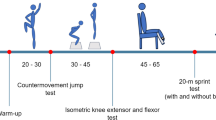Abstract
The purpose of the present experiment was to investigate the immediate effects of a cycling exercise on postural control during quiet standing in healthy young adults. To this aim, 12 university students were asked to stand upright as immobile as possible, with their eyes closed, prior to and following a 15 min cycling exercise performed at a power output of 200 W. Centre of foot pressure (CP) displacements, recorded using a force platform along both the medio-lateral (ML) or antero-posterior (AP) axes, were used to compute the motions of the vertical projection of the centre of gravity (CG v ) and those of the difference between the CP and the CG v (CP − CG v ). Metabolic (heart rate, respiratory exchange ratio and blood lactate concentration) and psychological (rate of perceived exertion) measurements ensured that subjects were fatigued at the end of the cycling exercise. The cycling exercise induced a decreased of both CG v and CP − CG v motions along the AP-axis, whereas no significant changes were observed along the ML-axis. These discrepancies of the postural effects according to the direction of balance are likely to stem from the directionally sensitive activity of postural muscles, when considering (1) what the cycling exercise involved in terms of joints and tendons receptors stimulation and lower limb muscles recruitment (i.e. sagittal plane movers of the lower extremities) and (2) the skeletal muscles involved in postural control during quiet standing (i.e. sagittal and frontal plane movers of the lower extremities for the AP and ML balance, respectively).



Similar content being viewed by others
References
Borg G (1970) Perceived exertion as an indicator of somatic stress. Scand J Rehabil Med 2:92–98
Brenière Y, Do MC, Bouisset S (1987) Are dynamic phenomena prior to stepping essential to walking? J Mot Behav 19:62–76
Caron O, Faure B, Brenière Y (1997) Estimating the center of gravity of the body on the basis of the center of pressure in standing posture. J Biomech 30:1169–1171
Derave W, De Clercq D, Bouckaert J, Pannier JL (1998) The influence of exercise and dehydration on postural stability. Ergonomics 41:782–789
Ericson MO, Nisell R, Arborelius UP, Ekholm J (1985) Muscular activity during ergometer cycling. Scand J Rehabil Med 17:53–61
Gauchard GC, Gangloff P, Voudriot A, Mallié JP, Perrin PP (2002) Effects of exercise-induced fatigue with and without hydration on static postural control in adult human subjects. Int J Neurosci 112:1191–1206
Lepers R, Bigard AX,·Diard JP, Gouteyron JF, Guezennec CY (1997) Posture control after prolonged exercise. Eur J Appl Physiol 76:55–61
Nault ML, Allard P, Hinse S, Le Blanc R, Caron O, Labelle H, Sadeghi H (2002) Relations between standing stability and body posture parameters in adolescent idiopathic scoliosis. Spine 27:1911–1917
Nardone A, Tarantola J, Giordano A, Schieppati M (1997) Fatigue effects on body balance. Electroencephalogr Clin Neurophysiol 105:309–320
Roberts D, Ageberg E, Andersson G, Friden T (2003) Effects of short-term cycling on knee joint proprioception in healthy young persons. Am J Sports Med 31:990–994
Rougier P, Burdet C, Farenc I, Berger L (2001) Backward and forward leaning postures modelled by a fBm framework. Neurosci Res 41:41–50
Wassermann K, Whipp BJ, Koyal SN, Beaver WL (1973) Anaerobic threshold and respiratory gas exchange during exercise. J Appl Physiol 35:236–243
Winter DA, Prince F, Franck JS, Powel C, Zabjek KF (1996) Unified theory regarding A/P and M/L balance in quiet standing. J Neurophysiol 75:2334–2343
Acknowledgments
This paper was written while the first author was ATER at Université de Savoie, France. The authors gratefully acknowledge N. Horvais and Ch. Ringaud for their technical assistance in the collection of data for this experiment, PPEH research unit, Jean Monnet University, Saint-Etienne, France and EA 479 Physiopathologie Cardiovasculaire et Prévention, Besançon, France for blood lactate concentration and gas analyses measurements. The authors would like to thank the anonymous reviewers for helpful comments and suggestions. Special thanks are also extended to Ben H. and Zora B. for various contributions.
Author information
Authors and Affiliations
Corresponding author
Rights and permissions
About this article
Cite this article
Vuillerme, N., Hintzy, F. Effects of a 200 W–15 min cycling exercise on postural control during quiet standing in healthy young adults. Eur J Appl Physiol 100, 169–175 (2007). https://doi.org/10.1007/s00421-007-0419-6
Accepted:
Published:
Issue Date:
DOI: https://doi.org/10.1007/s00421-007-0419-6




